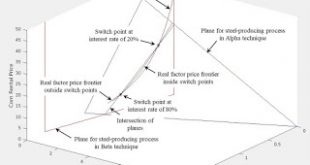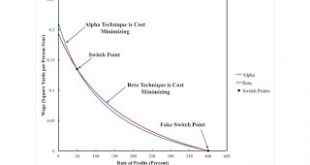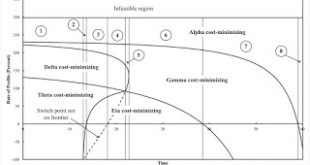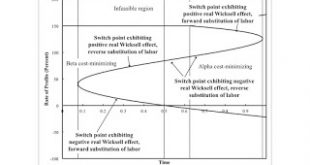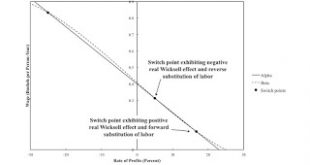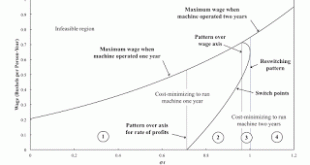Figure 1: Real Factor Price Frontier1.0 Introduction Carlo Milana has proposed a new way of visualizing the choice of technique, including in the case of reswitching. This way of describing what he has done is not neccessarily how he thinks of it. In this post, I describe his approach with a reswitching example, in a model of the production of commodities by means of commodities. 2.0 Technology Table 1 shows the coefficients of production for this example. Coefficients of production...
Read More »A Fake Switch Point in an Example With Circulating Capital
Figure 1: A Switch Point and a Fake Switch Point on Wage Curves1.0 Introduction In the analysis of the choice of technique, I typically consider examples of technology with a finite number of techniques. For each technique, I find the wage as a function of the rate of profits. The outer envelope of these curves shows the cost-minimizing technique at each rate of profits (or each level of the wage). Points on more than one wage curve are switch points. This approach is valid when, for...
Read More »Structural Economic Dynamics And Reswitching In A One-Good Model
This post, as suggested, extends this one-good example. I assume a constant returns-to-scale technology, as specified in Tables 1 and 2. Labor is advanced to the capitalists, and wages are paid out of the surplus at the end of the year (period of production). The capitalists (incorrectly) expect the technology in existence at the start of the year to continue to exist. I assume prices of (re)production prevail. Table 1: Inputs for The Technology InputProcess(I)(II)(III)Labor30 eσ0,1(1 -...
Read More »Harrod-Neutral Technical Progress and Fluke Switch Points
Figure 1: A Pattern Diagram I have put up a working paper with the post title. Abstract: This article considers Harrod-neutral technical progress in the context of an analysis of the choice of technique. In a model of the production of commodities by means of commodities, neutral technical change is compatible with the reswitching of techniques, capital reversing, process recurrence, and the reverse substitution of labor. A taxonomy of fluke switch points is applied to an example,...
Read More »On Hicks’ Average Period of Production
Figure 1: APP Around Switch Points1.0 Introduction I take it that the Austrian theory of the business cycle builds on Austrian capital theory. The following two claims are central to Austrian capital theory: Given technology, profit maximizing firms adopt a more capital-intensive, more roundabout technique at a lower interest rate. The adoption of a more roundabout technique increases output per worker. Originally, Eugen von Böhm-Bawerk proposed a physical measure of the average period...
Read More »All Combinations of Real Wicksell Effects, Substitution of Labor
Figure 1: A Pattern Diagram Consider an example of the production of commodities, in which many commodities are produced within capitalist firms. Suppose two techniques are available to produce a given net output. These techniques use the same set of capital goods, albeit in different proportions. They differ in process in use for only one industry. Given the qualification about the same capital goods, generic (non-fluke) switch points are the intersection of the intersection of the wage...
Read More »Positive Real Wicksell Effect, Forward Substitution Of Labor
Figure 1: Wage-Rate of Profits Curves Consider a comparison of comparison of stationary states. Net output is taken as given, and a unit of net output is the numeraire. Technology consists of a finite set of techniques. In each technique, net output is produced from inputs of labor and produced circulating capital goods. No fixed capital is used, and land of the best quality is in such abundance that it is free. Also assume constant returns to scale. One can find a wage-rate of profits...
Read More »Some Experts On The Cambridge Capital Controversy
Many years ago, I used to argue, on Usenet, about the Cambridge Capital Controversy. Many mainstream economists used to ignorantly assert, when pretending to respond, that an application of the CCC to labor economics was my idea alone. So I used to demonstrate that this was false by quoting from the literature. As far as I can see, mainstream economists are still mostly trained into ignorance. P. Garegnani: "The idea that demand and supply for factors of production determine...
Read More »Pattern Analysis Applied to Structural Economic Dynamics with a Choice of Technique: A Numerical Example
I have made a working paper with the above title available on SSRN. Abstract: This article illustrates the application of pattern analysis to structural economic dynamics with a choice of technique. A numerical example is presented in which technical progress is introduced. Examples of temporal paths through the parameter space illustrate variations of the wage frontier. A single technique is initially uniquely cost-minimizing for all feasible rates of profits. Eventually, the technique...
Read More »Pattern Analysis for a Fixed Capital Example
Figure 1: A Pattern Diagram1.0 Introduction In this example, I perturb parameters in an example of Bertram Schefold's. I was disappointed in that, as far as I can see, one can analyze the choice of technique in this example by the construction of the wage-rate of profits frontier. As far as I understand, this is not true for joint production in general. I guess I also need to find an example in which the physical life of a machine is at least three years so as to find a three-technique...
Read More » Heterodox
Heterodox

